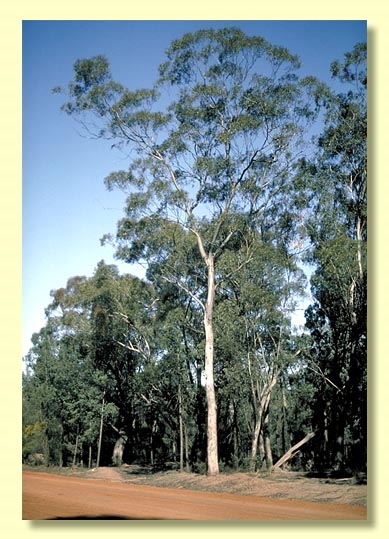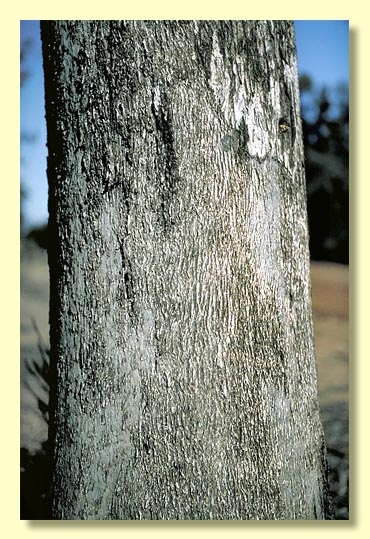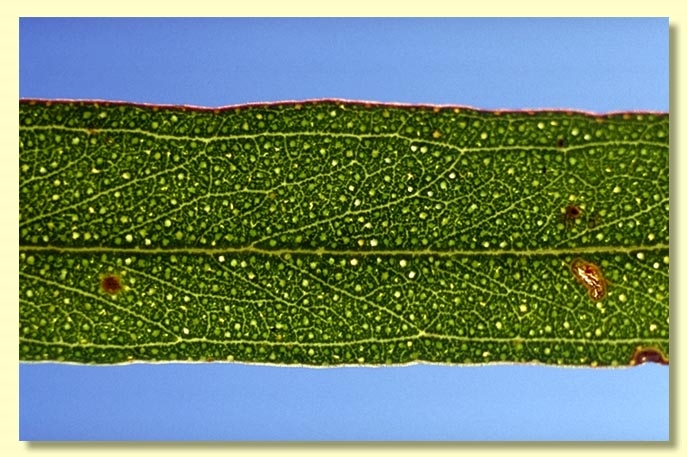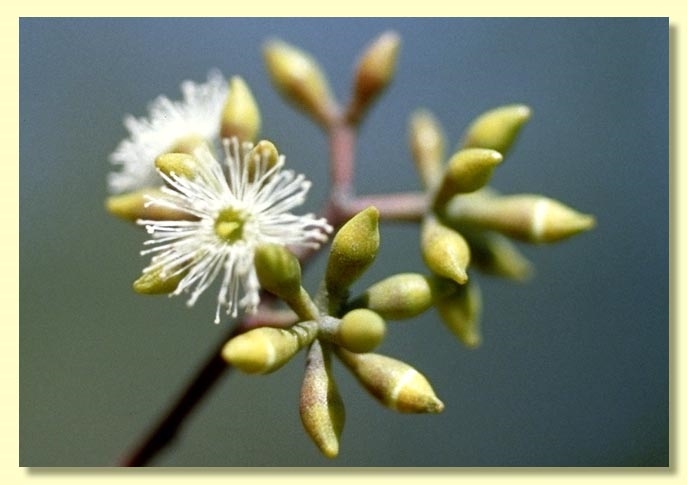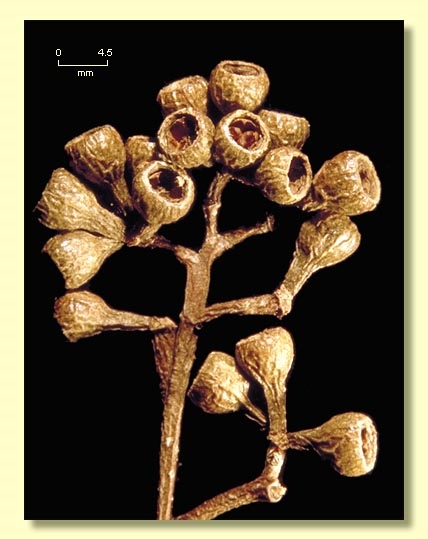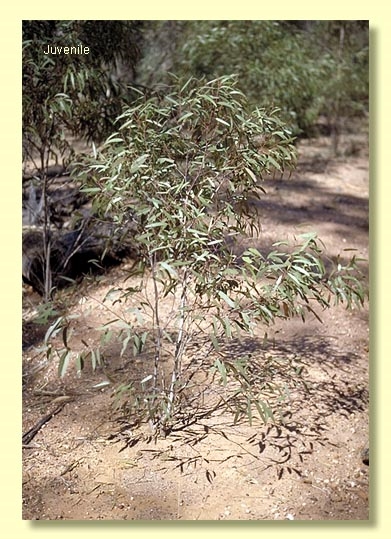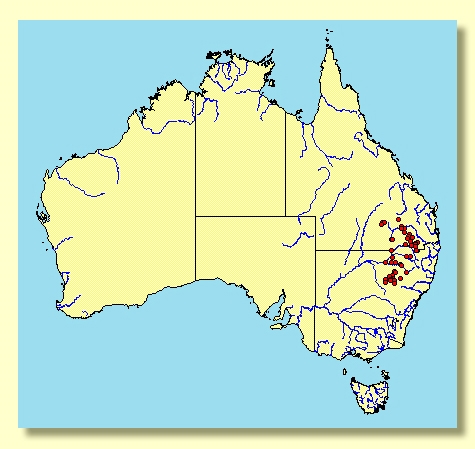Euclid - Online edition
Eucalyptus woollsiana
Eucalyptus | Symphyomyrtus | Adnataria | Apicales | Buxeales | Continentes
Type citation: Girilambone, Cobar and Trangie (W. Bäuerlen); Nyngan and Murga (R.H. Cambage ).
Type: New South Wales. Nyngan, June 1900, R.H.Cambage s.n. (lectotype: NSW321382) fide A.R. Bean, Austrobaileya 8(1): 27-30 (2009) [this reference contains extensive discussion of the identity of the Baker syntypes].
Eucalyptus odorata var. woollsiana Maiden, Crit. Revis. Eucalyptus 2: 32 (1910). T: all from NSW: Mount Boppy near Cobar, J.L.Brooman s.n.; Girilambone to Condobolin, W.Baeuerlen s.n.; Condobolin, R.H.Cambage, s.n.; Gilgandra, R.H.Cambage, s.n.; on plains near Baradine, W.Forsyth, s.n.; 18 miles from Dubbo, W.Forsyth s.n.; Castlereagh River, W.Woolls, s.n.; Narrabri, Nov. 1899, J.H.Maiden s.n. ; Narrabri West, J.L.Brooman, s.n.; Denman, W.Heron, s.n.: (syntypes, all held at NSW) fide A.R.Bean (ibid.).
Eucalyptus pilligaensis Maiden, J.H., Journal and Proceedings of the Royal Society of New South Wales 54: 163 (1921). Type: Narrabri, Nov. 1899, J.H.Maiden s.n.; holo: 2 sheets NSW322074, NSW322075, fide A.R.Bean (ibid.).
Bark rough to 10–15 cm diameter branches, box-type or finely tessellated, grey or mottled grey and white; smooth bark pale grey to coppery.
Juvenile growth (coppice or field seedlings to 50 cm): stem rounded in cross-section; leaves opposite and subsessile for a few nodes then alternate and shortly petiolate, linear, 6–15 cm long, 0.3–1.5 cm wide, base tapering to petiole, green.
Adult leaves alternate, petiole 0.5–1.5 cm long; blade narrowly lanceolate to linear, 7.5–13.5 cm long, 0.6–1.5 cm wide, base tapering to petiole, concolorous, glossy or dull, green, side-veins acute, moderately to densely reticulate or sometimes obscure, intramarginal vein parallel to and remote from margin, oil glands island and intersectional.
Inflorescence terminal compound, or compound in subterminal axils, peduncles 0.3–1 cm long, buds 7 or 9 per umbel, pedicels 0.1–0.4 cm long. Mature buds diamond-shaped to clavate or ovoid, 0.2–0.5 cm long, 0.2–0.3 cm wide, green, scar absent, operculum conical, stamens irregularly flexed, with outer staminodes or stamens all perfect, anthers adnate, globoid, dehiscing by small lateral or subterminal pores, style long, stigma blunt, locules 4, the placentae each with 4 vertical ovule rows. Flowers white.
Fruit on pedicels 0.1–0.4 cm long, cup-shaped to obconical, hemispherical or spherical, 0.2–0.4 cm long, 0.2–0.4 cm wide, disc descending, valves 4, near rim level or enclosed.
Seeds dark brown, 0.8–1.3 mm long, flattened-ovoid, dorsal surface shallowly pitted, hilum ventral.
Cultivated seedlings (measured at ca node 10): cotyledons reniform to oblong; stems rounded or square in cross-section; leaves petiolate, opposite for 3 to 6 pairs then alternate, linear to narrowly lanceolate, 7–12.5 cm long, 0.6–1.5 cm wide, base tapering, margin entire, apex pointed, dull, green.
Flowering has been recorded in February, March, April, May, July, August and September.
A small to medium-sized woodland box tree of the North-western slopes and plains of New South Wales north of Condobolin and Dubbo into south-eastern Queensland extending to the Dalby, Miles and Roma areas, on moderately fertile heavier soils. One of the grey boxes, it has rough bark over the trunk extending to the base of the branches and very narrow glossy green adult leaves and similarly narrow juvenile leaves. It is closely related to E. microcarpa which has broader juvenile and adult leaves and slightly larger buds and fruit. It is not always possible to decide whether a grey box specimen is E. woollsiana or E. microcarpa without using juvenile leaves. Other box-barked species occurring within the geographic range of E. woollsiana are E. conica which sheds the outer uperculum early in bud development and has flowers with the outer stamens lacking anthers, and the frequently glaucous E. albens which has much larger buds, barrel-shaped fruit, dull broad adult leaves and large ovate juvenile leaves. The smaller, mallee box species, E. viridis also occurs within the broad geographic area where E. woollsiana is found but occupies stony sites and has shorter more cupular fruit and less rough bark.
In the classification of Brooker (2000) Eucalyptus woollsiana (as E. pilligaensis) was placed in Eucalyptus subgenus Symphyomyrtus section Adnataria (the boxes) because the buds have two opercula, ovules are in four rows, seeds are flattened-ovoid, cotyledons are reniform, and anthers are rigid on the staminal filaments. Within section Adnataria, E. woollsiana is part of a subgroup, series Buxeales subseries Continentes, further distinguished by having buds that retain the outer operculum until flowering time when both opercula are shed together. Most species in this group are from eastern Australia and have all stamens fertile and are woodland trees of hills and plains, often dominant in the landscape, viz. E. albens, E. moluccana, E. microcarpa and E. woollsiana. Others, viz. E. viridis, E. polybractea, E. froggattii, E. odorata, E. albopurpurea and E. porosa, are mallees, some of them also occurring as small trees occasionally.
The closely related species E. moluccana, E. microcarpa and E. woollsiana differ mainly in the size of the juvenile leaves, other dimensions being overlapping to various degrees:
Fruit
l x w cm
Adult leaves
l x w cm
Juvenile leaves
l x w cm
Juvenile leaves
l:w ratio range
woollsiana
0.2-0.4 x 0.2-0.4
7.5-13.5 x 0.6-1.5
6-15 x 0.3-1.5
(6)10-20
microcarpa
0.3-0.9 x 0.3-0.5
6-15 x 1-3
6-15 x 3-5.5
2-3
moluccana
0.3-0.7 x 0.3-0.6
7-17 x 1.5-6.5
4-8 x 2.5-5.5
1.5-2
Based on specimens at CANB
Not all specimens of E. microcarpa and E. woollsiana will be easily identified and, without juvenile leaves, may be impossible to assign to one name or the other. The southern distributional limits of E. woollsiana into the NSW South-west Plains region as far south as Ardlethan and Narrandera is asserted by Bean (2009) but questioned here in EUCLID. Botanists wishing to identify specimens with certainty will need make careful field collections including notes on habitat and local variation between trees; seed collection is usually easy and growing of seedlings for additional juvenile data will aid identificarion with juvenile leaf length: width ratios being the best guide - if using seedlings make this measurement higher than the point where seedling leaves cease to be opposite on the stem i.e. have become alternate.

